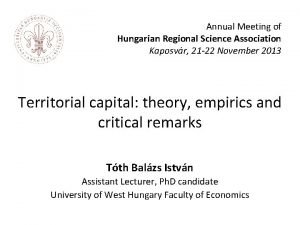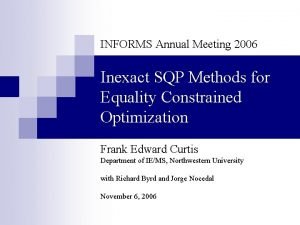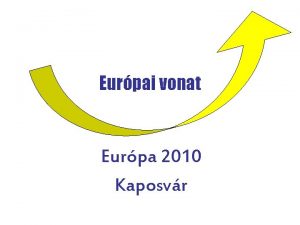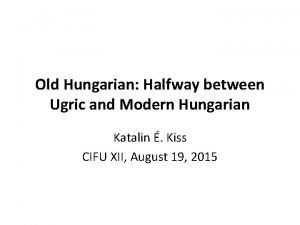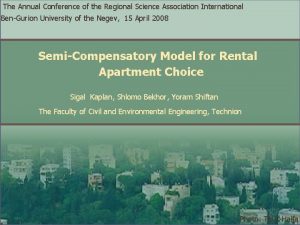Annual Meeting of Hungarian Regional Science Association Kaposvr













- Slides: 13

Annual Meeting of Hungarian Regional Science Association Kaposvár, 21 -22 November 2013 Territorial capital: theory, empirics and critical remarks Tóth Balázs István Assistant Lecturer, Ph. D candidate University of West Hungary Faculty of Economics

Introduction: some ‘preconditions’ of TC • Why has the concept of TC become remarkable in recent years? – Increasing complexity of world economy, intensification of globalization – Appreciation of local values, endogenous resources (territorial assets), endogenous growth and path-dependency – Fragile and unequal development (especially in the EU) – Criticism of the cohesion policy of the European Union – Changing concepts of ‘sustainability’ – Diversified ideologies of regional science: • Need for a new interpretation and explanation of regional development • Shift from hard and technical analyses to soft, speculative and critical examinations • Resurgence of supply-oriented approaches

The ‘evolution’ of TC ONLY CONCEPTUALISATION Basic theory and model Application of the concept Empirical investigations Territorial cohesion Regional growth, territorial competitiveness Tóth Copus et al. Territorial governance Zonne-veld -Waterhout Rural development European Commission OECD Territorial Outlook LEADER EO 1999 2001 Giffinger. Suitner Regional Competitiveness: Towards a Concept of Territorial Capital Empirics (empirics+theory) Camagni Zonne-veld -Waterhout 2005 Coutney et al. Ventura et al. Capello Finka Marsh Waterhout ATTREG Giffinger. Hamedinger Servillo et al. Camagni. Capello Brasili et al. Atkinson Brasili Camagni, R. Attractiveness Sarmiento. Mirwardt V. Berkel. Verburg Camagni et al. Capello et al. Pompili. Martinoia Giffinger. Hamedinger Affuso. Camagni Veneri Caragliu. Nijkamp Camagni. Capello Percucca Giffinger Davoudi et al. Kunzmann Rota Tóth Casi. Resmini Tóth 2007 2008 2009 2010 2011 2012 2013 Source: own construction

Symbolic capital Social capital Settlement capital Relational capital Produced capital X Political capital Institutional capital X Physical capital Infrastructural capital X X X Natural capital Human capital Financial capital Environmental capital Entrepreneurial capital Economic capital Cultural capital Creative capital Cognitive capital Built capital Main types of capital in some ‘capital frameworks’: a comparison Types of capital in publications not relating to the concept of TC Kitson et al. (2004) Emery–Flora (2006) Agarwal et al. (2009) Stimson et al. (2011) Carayannis et al. (2012) X X X X X X Types of capital in publications relating to the concept of TC Camagni (2008) Affuso–Camagni (2010) Ventura et al. (2010) Brasili (2011) Brasili et al. (2012) Mazzola et al. (2012) Servillo et al. (2012); Atkinson (2013) Tóth (2011) X X X X X X X X X Source: own construction X X X X X

Measuring TC: a comparison Affuso–Camagni (2010) Brasili (2011) Camagni et al. (2011) Pompili–Martinoia (2011) Veneri (2011) Brasili et al. (2012) Mazzola et al. (2012) Camagni–Capello (2013) Perucca (2013) Tóth (2011; 2013 a) Tóth (2013 b) Applied method(s) Case study Period Dimensions of territorial capital MASST-model (econometric model) Provinces of ‘Latin Arc’ 118 cities of the EU Long term approach Infrastructural capital, settlement structure, sectoral and natural specificities, social and relational capital Productive capital, cognitive capital, environmental capital, infrastructural capital, settlement capital Principal component analysis Descriptive analysis Cluster analysis Analysis of variance Spatial autocorrelation Factor analysis Cluster analysis Principal component analysis Standardizing Indexing Descriptive analysis Panel with fixed and random effects MASST-model (econometric model) Principal component analysis Analysis of variance Multiple lin. regression Italian provinces (NUTS 3) 2006 -2007 2006 (most of the data) Relational capital, human capital Italian provinces (NUTS 3) Long term Cultural capital, natural capital, human capital, economic approach performance, tourism, labour 2001 Social capital, socio-cultural identity, spatial organization (most of the data) of activities and governance Productive capital, cognitive capital, social capital, Italian provinces 2002 -2004, 2009 relational capital, environmental capital, human capital, (NUTS 3) settlement capital, infrastructural capital Social capital, natural capital, physichal capital, human Italian provinces 1999 -2011 capital, institutional-relational capital, entrepreneurial(NUTS 3) relational capital, cognitive capital, public-private capital 259 regions of the 2015 Entrepreneurship, creativity, social overhead capital, EU (NUTS 2) (forecast, scenario) receptivity Italian provinces (NUTS 3) 1999 -2008 Factor analysis Cluster analysis Hungarian medium -sized cities 2009; 2010 Discriminant analysis Hungarian subregions (LAU 1) 2006 -2011 Source: own construction Public capital, attractiveness, private capital, social capital, human capital, relational capital Profit, added value and income, natural and built environment, supply and services, education and community culture, social features, attractiveness Economic capital, natural capital, built capital, human capital, cultural capital, social capital

X X X X X X X X X X X X X X X X X X Tóth (2013 b) X Tóth (2011, 2013 a) Perucca (2013) X Camagni – Capello (2013) X X X X X Mazzola et al. (2012) Brasili et al. (2012) Pompili– Martinoia (2011) Camagni et al. (2011) Veneri (2011) … bank sector … business environment, entrepreneurship … community culture … crimes … education, knowledge, creativity … employment … foreign trade, export and import … income, capital stock … infrastructure … migration … natural environment, environmental protection … number of population, population density … patent applications … public institutions … (public) transport … receptivity … research and development … social conditions, social features … supply and services … tourism … voluntary activity Brasili (2011) Indicators relating to… Affuso– Camagni (2010) Measuring TC: a comparison X X X Source: own construction X X

Types of Hungarian medium-sized cities based on territorial capital Ózd Salgótarján Mosonmagyaróvár Sopron Pápa Szombathely Ajka Zalaegerszeg Keszthely Vác Gyöngyös Dunakeszi Hatvan Tata Szentendre Hajdúböszörmény Tatabánya Gödöllő Budaörs Jászberény Vecsés Karcag Érd Hajdúszoboszló Cegléd Gyál Szolnok Szigetszentmiklós Dunaharaszti Várpalota Törökszentmiklós Veszprém Nagykőrös Siófok Dunaújváros Békés Kiskunfélegyháza Szekszárd Komló Hubs of significant territorial capital (7) Eger Esztergom Nagykanizsa Kaposvár Kazincbarcika Medium-sized cities with considerable territorial capital (5) Kiskunhalas Baja Békéscsaba Szentes Hódmezővásárhely Makó Medium-sized cities with considerable capacity in tangible assets and with moderate capacity in intangible assets (6) Source: own calculations Gyula Orosháza Medium-sized cities with average (moderate) territorial capital (29) Developing or territorial capitaldeficient mediumsized cities (5)

Sub-regions of lower permanent domestic emigrations Built capital – Human capital + Function 2 Built capital + Human capital – Attractiveness of Hungarian sub-regions based on some dimensions of territorial capital Sub-regions of permanent domestic immigrations Sub-regions of higher permanent domestic emigrations Economic capital – Cultural capital – Function 1 Economic capital + Cultural capital + 1 2 3 Centroid Functions Function 1 Function 2 Structure matrix 1. Economic capital I. 0, 807 (private fixed capital) (0, 000)* 2. Economic capital II. 0, 749 (income, tax) (0, 000)* 3. Cultural capital 0, 235 (community culture) (0, 037)* 4. Built capital 0, 801 (accessibility, (0, 000)* institutions) 5. Human capital 0, 462 (education, patents) (0, 027)* 6. Natural capital -0, 203 (green public spaces) (0, 334)** 7. Social capital -0, 123 (crimes, poverty, aid) (0, 813)** Eigenvalue 0, 675 0, 156 % of Variance 81, 3% 18, 7% Canonical correlation 0, 635 0, 367 Wilks’ Lambda 0, 517 0, 865 Chi-square; 110, 994; 24, 291; df; Sig. 14; 0, 000 6; 0, 000 Source: own calculations

Some critical remarks • It is still unclear whethere is a common understanding of TC: – Since OECD (2001) no additional definitions were published – There are problems with the OECD definition: is it a real definition or a list of territorial assets? • TC is not adequate for many criteria of ’capital’: – TC is rather not ’capital’ according to e. g. Elster (1997), Adler-Kwon (1999), Arrow (1999), Solow (1999), Robison et al. (2002) • Not every component of TC is appropriate for statistical analyses: – There is no consensus which dimensions of TC should be measured – There are great differences concerning the applied methods, the indicators and case studies – Is it a static or a dynamic phenomenon?

Some critical remarks • It is still unclear whethere are relations between TC and some other terms used in regional economics / regional (local) economic development: – Competitive advantages, regional specialization, regional development, territorial competitiveness, location factors, economies of scale, intelligent specialisation etc. • ‘Territorial capital paradigm’ fundamental research problem: – TC is a new paradigm following the basic meaning of Oxford English Dictionary – TC is not a paradigm following T. Kuhn’s definition (1970) on paradigm – In stead of ‘paradigm’: ‘change in style’ (Hacking 1985), ‘change in the discipline’s core model of reality’ (Lakatos 1978), ‘evolutionary process’ (Popper 1972), ‘self correcting process’ (Sagan 2002) etc. may be more appropriate

Some critical remarks • TC concept is still missing from local economic development strategies: – All strategies identify the characteristics of regions well, but do not include them in the development of vision (Banski 2013): There is a need not only for TC diagnosis, but for TC synthesis as well Exploration and analysis + formulating vision + defining goals are based on TC

Conclusions and proposals • The concept of TC is of great importance but has not been researched in the necessary depth yet • Further scientific research needs to be completed: – Through the concept of TC scientists may get a better picture in relation of the main ideologies and theories in economics and in regional science: TC provides an appropriate analytical framework to study regional economic processes – TC may be appropriate to explain territorial development more precisely: scientists are able to systemize the endogenous factors of territorial development more accurately • The approach of territorial capital can widen the visions of territorial development policies, providing new techniques and methods for strengthening territorial competitiveness in Central and South East Europe, also in Hungary

Thank you for your attention! tothbalazsistvan@ktk. nyme. hu
 Kaposvr
Kaposvr American psychiatric association annual meeting 2020
American psychiatric association annual meeting 2020 Informs annual meeting
Informs annual meeting Aupha annual meeting
Aupha annual meeting Grand lodge of ky annual meeting
Grand lodge of ky annual meeting Positron vs proton
Positron vs proton Cwemf
Cwemf How to run an annual general meeting
How to run an annual general meeting Nrg oncology meeting 2019
Nrg oncology meeting 2019 Aashto annual meeting 2015
Aashto annual meeting 2015 Scts annual meeting
Scts annual meeting Nrg oncology meeting 2017
Nrg oncology meeting 2017 American epilepsy society annual meeting 2017
American epilepsy society annual meeting 2017 Travel health insurance association annual conference
Travel health insurance association annual conference
